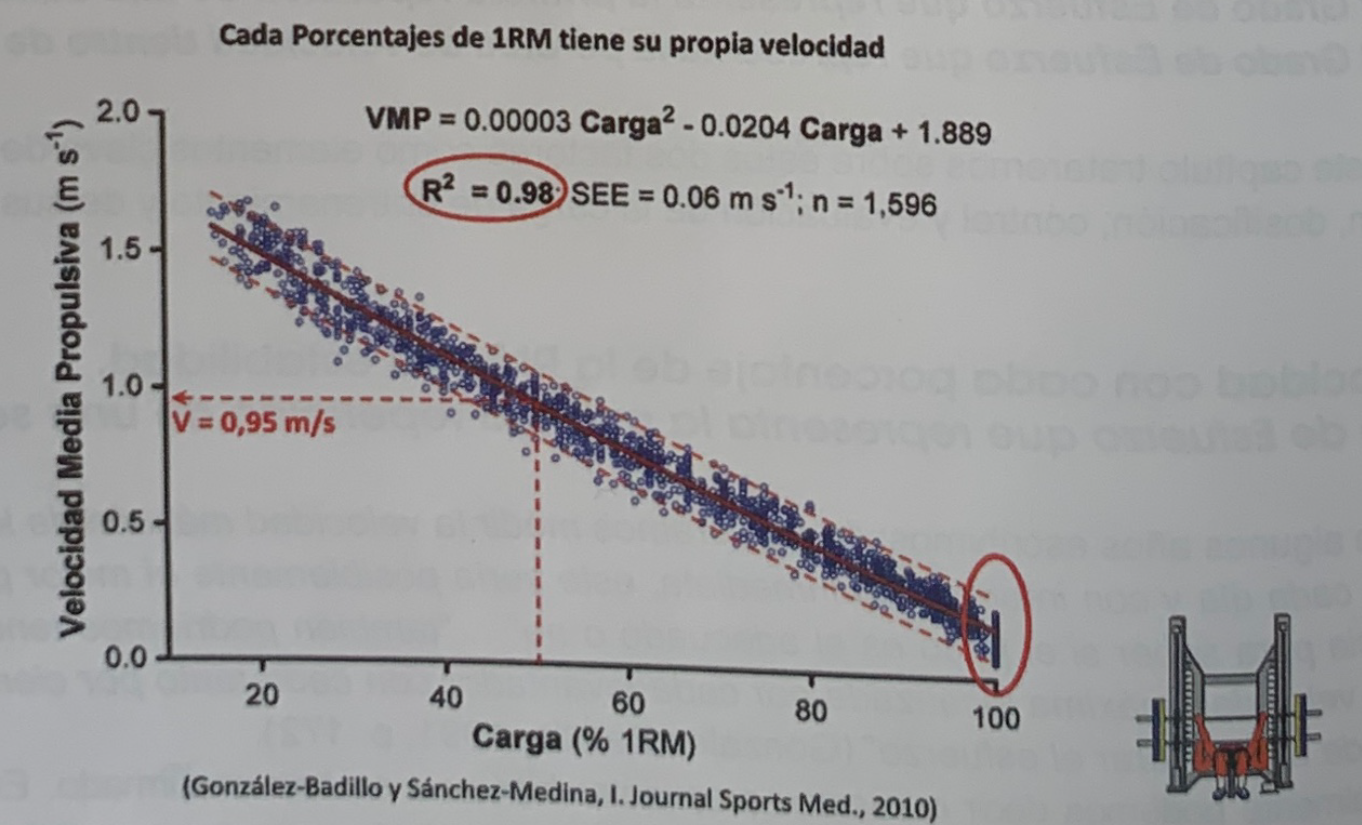The organization of strength training through speed
In this article an analysis of the guidelines on the organization of strength training through speed is made.
In this series of articles we deal with some of the most important concepts of strength training, collecting notes from the recently published book Strength, Speed and Physical and Sports Performance written by renowned researchers Juan José González Badillo and Juan Ribas Serna.
SUMMARY
- During training, the load can be modified to adjust the degree of effort with the programmed relative intensity.
- For the same loss of speed in the series, in all cases we will have useful information to know with high precision what training we have done, what degree of effort
- In training organized through speed, a determined number of repetitions in the series is not programmed, but rather a loss of speed in the series given the load or relative intensity selected.
First of all, it is convenient to take into account some prerequisites, taking into account that:
- The use of speed aims to provide information on the control of the training load and its effects.
- This information allows us to know with high precision with what relative intensity you train and with what degree of effort in the series, as well as what the training effect has been.
- For this information to be useful, the movements must be performed at the maximum possible speed, although the different values of execution speed are not associated with specific training objectives.
Daily adjustment of the absolute training load
During training, it is possible to decide whether or not to modify the absolute load when the degree of effort represented by the first repetition with said load is lower or higher than the one programmed.
This adjustment would be logical if we want to be consistent with the programmed actual load (we are only referring to the speed of the first repetition in this case), and would consist of increase or decrease the absolute load by 1 measure necessary so that the relative intensity with which you train equals the programmed relative intensity.

This control would contribute in a precise way to carry out the programmed training and not a different one, which is already a great advance in the training methodology. But this control does not ensure the good result of the training. And this can be due to two reasons:
- to that we have been able to make wrong decisions when programming the effort, or
- because the decision we’ve made—whether or not to change the absolute load—is wrong, or both.
However, for the same loss of speed in the series, in all cases we will have useful information to know with high precision what training we have done, what degree of effort (relative intensity and loss of speed) and what its effects are. This will allow us to make better decisions in the immediate future based on the data and real behavior of the athletes.
In practice, when we observe a discrepancy between the programmed effort (only speed of the first repetition in this case) and the one that means for the subject the displacement of the absolute load that said effort represents, three situations can occur:
- that the load moves at a higher speed than expected,
- moving at the expected speed, or
- to do it at a slower speed.
Naturally, in all cases three decisions can be made: maintain, raise or lower the load. But not in all cases these alternatives would be equally logical and reasonable.
If the load moves faster than expected
In the first case, if the absolute load moves at a higher speed than expected or programmed, it means that the subject has improved performance compared to what he had at the beginning of the training cycle, so it can be stated that the subject is training with a relative intensity lower than programmed.
The apparently most logical decision would be to increase the absolute load to the extent necessary to match the expected relative intensity. This would make it possible to comply in a very precise way with the programmed training (it is assumed that the loss of speed in the series would always be as expected).
But it is likely that when a subject clearly improves his performance after training for a few sessions, the most effective decision is to maintain the progression of the absolute loads predicted, even though the relative intensities with which he trains are less than those programmed.
In this way, a progressive load would be maintained in absolute terms, although the relative load remained more or less stable or even tended to regress, which would indicate that the performance improvement is greater.
In other words, we propose that it is probable that when the improvement in performance is important, the progression of the absolute loads is sufficient, and very favourable, for the improvement of performance, although the relative intensity remains stable or even decreases progressively. This decision should be kept as long as the performance improvement is maintained.
In any case, the speed measurement will continue to inform us of both the performance progression and the degree of effort that has caused it.
IF the load moves at the expected speed
In the second case, if the load moves at the expected speed and more than 6-8 training sessions have passed, the situation becomes worrying, because this would mean that the subject has not experienced any improvement in performance.
In this case, it would be necessary to analyze all the possible circumstances that could explain the lack of positive response. If no reasons unrelated to the training itself are found (illness, personal problems, excessive work or study…) and the subject recovers easily from one session to another, the decision should be made to increase the load, together with the introduction of some variability, apart from the increase in volume and intensity: training frequency, some different exercise…, but if, on the contrary, they are noticeable symptoms of fatigue, the load should be reduced.
If the load moves at a lower speed than expected
If, finally, the speed were lower than expected, an analysis of the possible causes would have to be carried out similar to that of the previous case. With non-training issues ruled out, it is unlikely that the reason for reduced performance is that the workload is low, so one should try to suspend the training session, or lower the absolute intensity to equal the expected relative intensity, or even lower it enough to get the speed above the programmed speed, and even take a rest or a few recovery sessions and increase the load again later.
What is indicated in the previous paragraphs is a great contribution of the measurement of speed: the coach knows the applied load and the effects that it produces permanently and immediately. It is the maximum and best information that a coach can aspire to in order to make informed decisions and improve his training methodology.
You have at your disposal, in each session, precise information on the training carried out and on the physical condition of the athlete or the person trained. This is what you need to make decisions that allow you to improve your own training as a coach and the performance of the people you train, of course, if you make the right decisions. But you will always have the information you really need to decide how to act.
The end result will depend on the technician’s ability to use that information.
The speed of the first repetition
Until now there has always been talk of the speed of the first repetition of the first series, which will indicate the relative intensity that represents the absolute load with which you train, but we have not said anything about how to manage this speed in the successive ones with the same exercise and absolute load.
In this sense, it should be considered that if more than one series is done, the absolute load will not change, even if the speed of the first repetition in successive series drops slightly. In addition, in each series the same loss of speed established for that session will continue to be applied, although, naturally, taking the speed of the first repetition of each series as a reference.
Therefore, what constitutes a training session is:
- an initial speed of the first repetition of the first set,
- The maximum speed possible in the successive series and,
- a loss of speed in the stable series during the total of the series performed.
This means that the speed of the first repetition of each of the successive series should be the maximum possible, and the absolute load will not be modified if there is a slight loss of speed with respect to that of the first series.
It would not make sense or practical feasibility to try to adjust the loads further for several reasons:
- First of all, because the losses are very small between the first repetitions of each series (it can be reduced or adjusted if desired by slightly increasing the recovery times between series). These losses are greater the greater the speed loss programmed for the first series, that is, the closer we get to the maximum number of repetitions possible in the series. But this is something that is part of the characteristics of the training itself.
- Secondly, because it is not feasible, without interfering in the training itself, to re-measure and make load changes in each series, because this would add significantly to the training load itself (greater number of repetitions and series than scheduled).
- Thirdly, because fatigue is part of the training and determines the degree of effort, and this would be uncontrollable if the absolute load is constantly changing. If we were to make these adjustments on each set in order to train each set at the same initial speed (same relative intensity), we would also need to do it on each rep of a set, because it is clear that as we do reps on each set, the relative intensity (the degree of effort) that each repetition represents is different, since the speed decreases progressively.
None of these changes seems recommendable and all are far from viable.
Repetitions per set are not scheduled
It has already been discussed on a few occasions, but it is necessary to indicate it at this time. In training organized through speed, a determined number of repetitions in the series is not programmed, but rather a loss of speed in the series given the load or relative intensity selected.
Carrying out speed-based training and programming the number of repetitions in the series is a contradiction and indicates little or no knowledge of the meaning of the already-hyped “speed-based training”. This means that not all the subjects will perform the same number of repetitions, the same volume, but the same degree of effort, which is what has been programmed and what, as it is reasonable to accept, determines the effect of the training.
On the contrary, if the same number of repetitions is programmed for the same relative intensity, the degree of effort will be different between the subjects.
Pre-training assessment
The evaluation prior to the start of a training cycle is carried out through a test with progressive loads.
What must be measured is the average propulsive velocity with which the subjects move each load. The maximum load reached in the test is a relative load (determined by speed) equal to or slightly higher than the maximum to be used in training. It will never be necessary to measure the MRI.
The evaluation after the training is carried out by analyzing the changes in the average propulsive velocity before the same absolute loads as in the initial test. If the speed with the maximum absolute load in the final test is clearly higher than that obtained in the initial test, an extra absolute load can be measured that could serve as a reference for the following training cycle. But this extra load would never be included in the evaluation of the evaluated training cycle, because it is not a load common to the two tests.



















